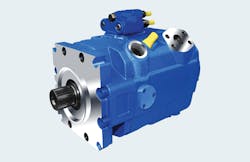Compact and quiet A11VO Series 40 axial-piston pumps are offered in five sizes with displacements ranging from 110 to 280 cc. Open-circuit pressure capacities are 350 bar nominal, 420 bar maximum. High power density and efficiency reduce fuel consumption and boost productivity of implement hydraulics on mobile equipment.
Universal through-drive combines easily with broad range of other pumps. Series includes numerous hydraulic and electrical control options.
Bosch Rexroth Corp., Mobile Hydraulics Div.
864.967.2777, www.boschrexroth-us.com


